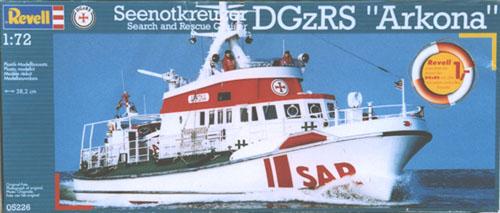
Kit review:
Search and Rescue Cruiser DGzRS "Arkona", Revell, 1/72 scale

By Christian Schonberger
Model length: 38,2cm = 15, 1/16th in
About the original vessel and the DGzRS:
The Arkona is part of the fleet of the DGzRS www.dgzrs.de- which counts around 60 vessels by now. DGzRS is short for: Deutsche Gesellschaft zur Rettung Schiffbruechiger - roughly translated: German society for the rescue of those at distress at sea - a non-governmental, highly efficient, independent organization founded in 1869, entirely financed by donations. Sister ships of the Arkona operate in the Noth- and Eastsea. This type, powered by three diesel engines, is designed to handle gale-force winds of over 100 km/h and waves over 5m high. They are of a very modern design with outstanding nautical capabilities including a high capacity fire extinguishing equipment and on-board hospital. The Arkona also contains a launch located at the aft part of the ship, designed for very shallow waters.
The contents of the kit box contain an adhesive sticker and a booklet describing the (in Germany well known) DGzRS complete with contact for donations.
I find it funny to see on the boxtop that for each kit sold, one "Deutschmark" (since January 1st 2002 of course replaced by the Euro) goes to the DGzRS. Well I hope that 50 Euro Cent of the price, the rough equivalent, actually did go to the organization. I paid 23 Euros, a very reasonable price for this kit.
The kit:
This is a 1999 release and itís nice to see that it is made to an established scale, even if
more often used for aircraft modeling.
The boxtop and side contains photos of the original vessel which of course are of great
help for the modeler regarding colors and detail.
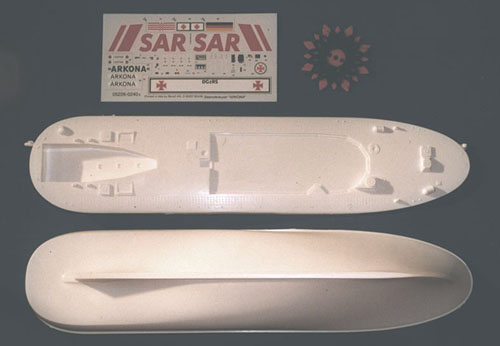
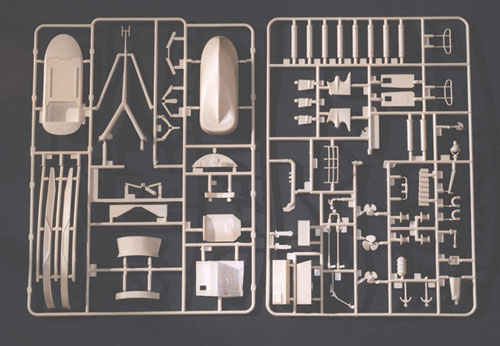
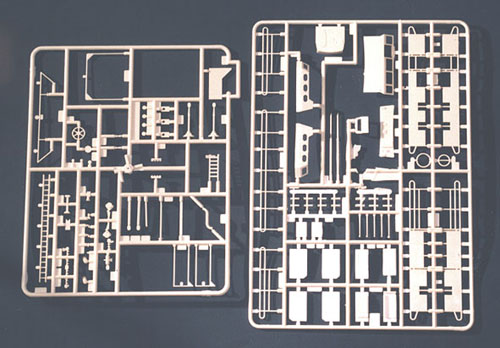
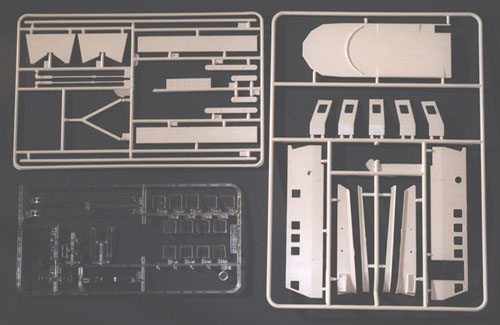
One sealed bag contains 6 frames and two large parts, the one piece hull and main deck, all parts molded in white. Another sealed bag contains one frame with parts molded clear. A very beautiful decal sheet, black rigging thread and comprehensive instructions in German and English complete the kit.
Opening the heat-sealed bag we find a one-piece hull that is cleanly molded except for the upper edge which is a bit irregular and needs attention (=sanding/filing), a large main deck part and 6 frames crisply molded with virtually no flash. The styrene is of high quality.
On the inside and sometimes outside of many parts we can see tool marks that most likely come from computer assisted machining. Light wet sanding will eliminate any trace of it. The same goes for some light scratches here and there, nothing to be concerned about.
Itís funny to see in a modern kit two parts of molded-in deck ropes on the large main deck piece. This is certainly a "holdover" from fondly (?) remembered times when styrene kits were young. These ropes can be removed relatively easily by sanding since the surface beneath is smooth. Anyway: I could have done without them.
Observing the parts we can see that everything is molded with crisp detail. All windows are open to receive the clear parts which even include detail of the rotating glass discs used for better visibility during heavy weather.
Railing, rivets and some fine detail parts are very slightly oversized but I didnít find this any reason to complain. The railings are actually very good and with some light sanding they will be very close-to-scale in cross section. There is no need for photoetched railings (which would be inappropriate for this large scale anyway due to its square cross section) or expensive brass fittings.
Since I didnít work on the model at the time I am writing this I cannot comment on the fits but upon closer inspection it looks as if all parts are virtually "falling into place" with just some light sanding/scribing with a hobby knife necessary to clean the parts a bit where necessary.
This looks like a kit which will look very good out-of-the-box but there is room for refinement.
To be honest, seeing a photo of the original vessel on the boxtop combined with the fact that this is a recent release, I would have expected the kind of impeccable detail companies such as Tamiya already delivered decades ago (pre CAD CAM!) and Revell in fact does deliver for example in some of their recent aircraft kits, but the kit reviewed here still falls a bit short. It could have been better. Accuracy of details could have been that notch above to make it a real great kit.
The foot steps of the radar/antenna mast, seen on the sharp and clear boxtop photo, are missing from the kit but experienced modelers will be able to add them using for example brass or copper wire or similar material. Nevertheless it would have been nice seeing them molded on.
The two protective wooden bars along the sides of the hull are separate parts and there are no markings on the hull where exactly to place them. The diagram in the (comprehensive) instruction booklet indicates that the intended location does not confirm 100% with the original when we compare it with the boxtop photo. I would have liked seeing the bars molded into the one-piece hull but that probably wasnít technically possible. In any case care should be taken to ensure correct alignment with the excellent decals.
I do not have any plans for comparison but this modern a kit can be expected to be of very high accuracy regarding overall measures and proportions. The moldmakers most likely have been supplied with first rate technical data by the DGzRS.
Bottom line: I highly recommend this kit. These typical German search and rescue vessels look great as display models and the Revell Arkona certainly is no exception. Any shortcomings (which are few) can be overcome by the more ambitious modeler.
Highs:
One piece hull
Finely molded parts in high quality styrene
Comprehensive decal sheet
High overall accuracy
Lows:
Molded-on deck ropes
Tool marks on some of the supposedly smooth outer surfaces
Detail and molding quality is a notch below what one can expect from this recent a kit
Rating: 8.5 out of 10